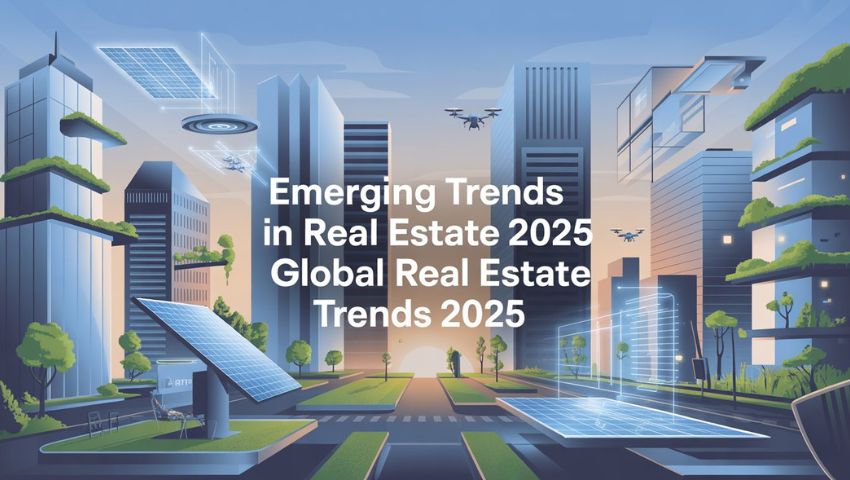The real estate market in 2025 is undergoing major changes driven by technology sustainability and new buyer preferences. From AI-powered analytics to eco-friendly housing and digital property investments the industry is evolving quickly. Whether you’re an investor or a first-time buyer, understanding these real estate trends will help you make smarter and more confident decisions.
After years of price swings and high mortgage rates 2025 is shaping up to be a year of steady growth. Insights from PwC’s Emerging Trends in Real Estate 2025 and ULI’s Emerging Trends in Real Estate 2025 show increasing optimism across Asia, Europe and the US. Markets like Pakistan and India are also seeing strong demand for gated communities and sustainable housing marking a new phase of real estate growth.
Picture standing at the edge of change that’s where the real estate market in 2025 is today. With AI virtual reality tours and green design reshaping how we buy and sell homes, opportunities are everywhere. In this guide we’ll explore the top real estate trends shaping the housing market in 2025 and show you where smart investors are moving next.
Quick Info
| Category | Key Trends 2025 | Impact on Market | Regional Insights |
|---|---|---|---|
| Global Real Estate Trends 2025 | Recovery in investment, focus on sustainability, AI integration | Stronger investor confidence and digital transformation | US, Europe, Asia |
| Real Estate Trends in 2025 (Asia) | Green buildings, co-living spaces, digital property listings | Increased affordability and eco-conscious development | Pakistan, India, Singapore |
| Emerging Trends in Real Estate 2025 | Smart homes, mixed-use spaces, virtual reality tours | Enhances buyer engagement and property value | Global adoption |
| PwC Emerging Trends in Real Estate 2025 | Interest rate stabilization, ESG-driven projects | More stable pricing and sustainable returns | North America & Europe |
| Real Estate Trends Pakistan 2025 | Gated communities, apartment living, overseas investment | Urban expansion and rising property demand | Islamabad, Karachi, Lahore |
| Real Estate Trends India 2025 | Affordable housing, smart city growth, co-working hubs | Boost in construction and rental yield | Mumbai, Bangalore, Delhi |
| Real Estate Market Trends Graph | Upward property value and rental yield trends | Better long-term investor returns | Global markets |
| Future Outlook (Real Estate Trends 2026) | AI-driven market predictions, virtual transactions | Greater efficiency and data-driven investing | Worldwide |
Why 2025 matters in the real estate market

After years of aftershocks from the pandemic supply-chain disruptions, rising interest rates and shifting work patterns the housing market is shifting out of a purely defensive mode into a more proactive one. To quote the joint report by Urban Land Institute (ULI) and PwC titled Emerging Trends in Real Estate® 2025 “The time has come.” (PwC) Stocks of property capital flows and buyer expectations are all being recalibrated.
For anyone involved in real-estate whether homeowner or investor that means one thing: you can’t rely solely on old playbooks. Instead you must understand the new dynamics of supply demand, interest rates demographics tech and sustainability. In the sections that follow we’ll use commonly spoken words, clear examples and anecdotes to bring these shifts to life.
Top Real Estate Trends Shaping the Housing Market in 2025 Pakistan
In Pakistan the property sector is resilient despite economic headwinds and the real estate trends in 2025 reflect both global impulses and local realities.
Key local observations
- In cities like Islamabad Karachi and Lahore price appreciation in key urban and gated-community segments continues albeit more moderately.
- There’s increasing interest from overseas Pakistanis to buy apartments or units in gated communities rather than large houses.
- Rental demand remains robust for mid-range apartments generating strong rental yields in certain neighbourhoods.
- At the same time high inflation and rising interest rates are impacting affordability for average-income buyers.
How these trends play out
Imagine this: Ali lives in Islamabad and is thinking of investing his savings. He looks at two options: a standalone house in a less developed area and a modern apartment in a gated community nearer to the city’s commercial zone. He chooses the apartment. Why? Because he’s observing that many overseas‐Pakistani buyers prefer gated apartments (easy maintenance, good amenities security) so the demand and yield feel safer. That anecdote reflects the wider shift: the housing market in Pakistan is adapting to global-style preferences even while local constraints persist.
What you should do
- If you’re a buyer/investor in Pakistan: target apartments in gated communities with good amenities, accessible transport and high tenant demand.
- For rental yield: calculate yield = annual rent ÷ purchase cost and compare with older houses that may cost more to maintain.
- For longer-term capital growth: watch for infrastructure developments (metro lines, new highways) that will raise property values.
- If you’re living in the property: think about future flexibility: will the home suit you in 5-10 years (kids parents mobility)?
Top Real Estate Trends Shaping the Housing Market in 2025 India
India’s housing market is undergoing its own transformation influenced by large demographic shifts, rising incomes, urban migration and changing buyer preferences.
What’s happening
- Demand for smaller homes, apartments and gated communities is growing especially in tier-2 and tier-3 cities.
- Developers incorporate more features like smart homes, energy efficient design green spaces and community amenities.
- Buyer focus is shifting: rather than just “big house near city centre” many now ask “how quick is transport? How reliable are services? Is rental demand strong?”
- Rental markets are heating up in cities where home-ownership is still difficult; so investors are seeing opportunities in the rental segment.
Anecdote to illustrate
Rani, a young professional in Bengaluru moved out of her family house into a smaller 2-bed apartment in a newly launched gated community. She said: “I needed less space, better amenities, security and lower maintenance. The old house felt like a burden.” Meanwhile a friend of hers is an investor and bought two such apartments in a suburb anticipating young professionals like Rani as his tenant pool. This story mirrors the large-scale shift in India’s market.
Suggested steps
- Focus on upcoming suburbs rather than only saturated city-centres; you may find better value and upside.
- Check developer reputation amenities (gym pool coworking green spaces) and expected maintenance charges.
- For investment rentals: look at tenant demographics (young professionals singles couples without kids) and pick homes accordingly.
- Think 5-10 year horizon: Mobility urbanisation and lifestyle changes will determine which properties succeed.
Emerging Trends in Real Estate 2025 Global Real Estate Trends 2025

Let’s move from regional foci to the global stage. Many of the trends shaping housing markets in Pakistan and India have global counterparts. Here are some of the most powerful emerging trends in real estate 2025 that span continents.
3.1 Interest Rates & Affordability
Globally real-estate markets are influenced heavily by interest rates. When borrowing costs are high fewer buyers can afford homes; when rates ease, more buyers step in. According to the Global Outlook 2025 by ULI & PwC markets are cautiously optimistic because “buyers and sellers of properties are edging closer to agreement on pricing.” (PwC) In the US for example the housing inventory is increasing (so the market is shifting from a pure seller’s market to a more balanced one). That means two things: one you may have more negotiating power; and two you must consider affordability more carefully.
3.2 Demographics & Changing Demand
Much of the global story revolves around population ageing smaller household sizes, migration (urban to suburban or between countries) and shifting lifestyle preferences. These demographic forces impact what kinds of homes are in demand (apartments vs houses; co-living vs traditional). (ULI Knowledge Finder) If you recognise these forces early you can pick properties that align with future demand.
3.3 Supply Constraints & Modernisation Needs
Globally new construction has been hampered by cost inflation, labour shortages and supply-chain disruptions. According to PwC/ULI “today’s critical real estate investment factors are supply dynamics and a modernised stock of buildings.” (PwC) What that means: older buildings may underperform; newer ones with better amenities, energy efficiency and tech features may attract premium rents and values.
3.4 Sustainability ESG & Resilience
The global reports highlight that sustainability resilience to climate-change effects and green buildings are no longer optional. In Europe especially the 2025 report notes data-centres renewable-energy-linked property and operational real-estate platforms among the strongest investment themes. (PwC) As a buyer or investor this means you should ask: does this property have good energy ratings? Is it resilient to climate risks (flooding heat storms)? What will upkeep cost in future?
3.5 Technology Data & PropTech
Technology is transforming how real-estate is bought, managed and rented. Virtual tours AI property valuation smart-home features and data-driven market-insights are gaining traction. (Times Union) For example, overseas investors can inspect properties remotely and make decisions faster. That gives a competitive edge.
3.6 Portfolio Diversification & Alternative Asset Classes
More investors are looking beyond traditional residential homes. Real-estate portfolios now include data-centres, logistics warehouses, co-living spaces and mixed-use developments. According to the reports, second-tier markets and alternative property segments are gaining interest. (Eventackle | Intelligence) As an investor you’ll want to think: Am I placing all my bets on one city or one property-type? Diversification may improve resilience.
Real Estate Trends Asia What Asia-Pacific Shows Us
In the Asia-Pacific region many of the global forces play out but with local twists: large population urbanisation, younger workforce migration and emerging middle-class demand.
What stands out
- Rapid urbanisation means demand for apartments and mid-rise housing rather than only sprawling houses in suburbs.
- Digital infrastructure 5G and data‐centre demand are strong as cities become smarter.
- Cross-border flows of capital particularly from overseas Asians investing in home countries are influencing housing markets.
- Supply chain shifts (near-shoring) and manufacturing relocation towards Asia are generating new demand for housing proximate to economic zones.
- Resilience matters: flood-prone coastal cities increasingly price in climate risk.
Step you can take
- If investing in an Asian market, split your focus between big metros and fast-growing suburbs.
- Target apartments or condos with good amenities and where younger professionals want to live.
- Check infrastructure: internet transport proximity to industrial or tech zones may add value.
- Consider currency risk and regulatory risk: capital flows in/out of Asia may be more volatile.
Real Estate Trends Europe Shifts Across the Atlantic
Europe’s real-estate sector is navigating specific challenges (older building stock, stronger regulation, slower growth) yet it presents interesting opportunities too. The 2025 Europe report notes a focus on digital infrastructure and operational real-estate platforms. (PwC)
European themes
- Data-centres and energy-infrastructure‐related real-estate rank high.
- ESG and climate compliance are heavy influences; some regions face regulatory risk if buildings are inefficient.
- Capital is flowing toward markets that combine stability with growth potential (e.g. secondary cities) rather than the over-heated primary markets.
What this means for you
- If you’re a global or multiregional investor looking at Europe may offer diversification and hedging.
- But you must evaluate regulation (zoning energy codes) taxation (property tax capital gains) and local market liquidity.
- Older stock may require refurbishment; that adds cost but might yield higher returns if you modernise.
Real Estate Trends in 2026 and Beyond The Horizon
While our focus is 2025 it’s wise to glance forward. The next cycle after 2025 is already forming.
What to watch for in 2026
- If interest rates start to fall borrowing conditions could improve dramatically which historically has led to housing booms.
- Demographics will shift further: ageing populations in many markets migration flows urban-to-suburb shifts.
- Climate hazards and insurance costs may increasingly influence property values.
- Technologies like AI valuation, IoT smart homes and blockchain for real-estate transactions may mature from novelty to standard.
- Supply pipelines (for housing industrial data) that were delayed may finish 2026-2027 influencing balance of demand & supply.
Keep your eyes open for
- Real estate market trends graph-type data showing inventory days on market price appreciation rental yield to spot turning points.
- Local markets in 2026 that earlier were “second-tier” may become mainstream and benefit from first-mover advantage.
- Policy changes: governments often intervene with tax incentives, zoning reforms, build-to-rent initiatives.
Real Estate Trends Article Step-by-Step Guide for Buyers & Investors

Now let’s walk through a clear actionable step-by-step guide that synthesises everything above and helps you buy with confidence.
Define your objective
- Are you buying to live or investing to rent/resell?
- What is your time-horizon (3 years 5 years 10-15 years)?
- What is your budget for both purchase cost and running (maintenance taxes) cost?
Research the market fundamentals
- Check inventory levels days on market median price comps rental yield in your target area.
- Understand interest-rate environment: what mortgage rates are being offered? What monthly payment can you afford?
- Analyse demographics: population growth age structure migration trends household size.
- Review supply pipeline: new construction planned/completed approvals zoning changes.
- Monitor policy & regulation: tax incentives subsidies foreign-investor rules ESG requirements.
Pick property type & location aligned with trends
- Based on your objective (live or invest) choose between house vs apartment city vs suburb primary vs secondary market.
- Prioritise properties with modern features: good amenities, energy efficiency, smart home security and accessible transport.
- Consider rental yield potential if investing: Amenity-rich apartments often outperform older houses in yield.
- For living: think about lifestyle and future-proofing (kids parents mobility job changes).
Financial modelling & risk analysis
- Compute expected costs: purchase price mortgage payment taxes insurance maintenance.
- For investment: compute expected rental income vacancy risk management cost yield.
- Stress test: What if interest rates rise further? What if the rental market slows? What if the area’s appeal reduces?
- Plan exit strategy: resale long-term hold refinance what will you do in 5 or 10 years?
Align purchase with major trend‐drivers
- Check energy/sustainability credentials (green building rating insulation solar flood risk).
- Confirm tech/amenity features (smart home controls EV charging coworking space).
- Evaluate how these features might impact resale value and rental demand.
- Make sure the building is jurisdictionally compliant (zoning regulations insurance risk) especially in climate-vulnerable areas.
Undertake due-diligence & negotiate smartly
- Inspect property thoroughly: quality of build maintenance records building management service charges.
- Check legal title developer credentials status of approvals.
- Use the current market environment to your advantage: if inventory is rising you may have negotiating leverage.
- Make sure all terms are clear: taxes, service fees, responsibilities, potential upgrade costs.
Secure financing & lock in favourable terms
- Compare lenders or mortgage options; fix rate vs variable.
- Factor in all costs (not just purchase price).
- If investing: reserve contingency fund for vacancy repairs tenant turnover.
- Ensure you’re comfortable with monthly payment and long-term hold cost.
Property management / living strategy
- If renting: decide to self-manage or hire a property manager; check tenant demand marketing strategy maintenance plan.
- If living: plan for future life changes (kids ageing mobility) and how the property adapts.
- Stay updated on local market changes: infrastructure developments, new supply population shifts.
Monitor market & adapt
- Regularly review performance: rental yield occupancy market comps resale enquiries.
- Keep an eye on real-estate market trends graph (inventory price growth days on market) for early signals of change.
- Be prepared to pivot: For example if you intend to hold long-term but local market cools you might rent instead of sell or vice versa.
- Use tech tools: virtual tours market-analysis platforms dashboards to stay informed.
Plan your exit and reinvestment
- Determine your exit: in 5-7 years? 10 years? Or hold indefinitely for rental income?
- On sale: factor in selling costs taxes market timing.
- If reinvesting: consider diversification (geography property type asset class) and align with emerging trends.
- Decide whether you’ll reinvest gains into another property or cash out and diversify into other assets.
Why You Can Invest With Confidence in 2025
Given all the above you might wonder: “Is now a good time to buy or invest in real estate?” The short answer is yes if you do so wisely and align with the right real-estate trends.
Reasons for optimism
- Demand fundamentals remain strong: people need homes; demographic trends favour certain types of housing.
- Inventory shifts and interest-rate changes may create buyer/investor advantage in many markets.
- Properties with modern amenities sustainability and smart features are distinguishing themselves.
- Technology allows better decision-making (virtual tours analytics) and access to broader markets (overseas investors).
- The global trend toward diversification means there are more opportunities in secondary markets and alternative property types.
However proceed with caution
- Higher interest rates still pose affordability issues just because rates may fall doesn’t mean they have yet.
- Local-market fundamentals matter more than national headlines: a headline might say “prices up globally” but your city could be flat or declining.
- Older properties or poorly maintained ones may underperform.
- Policy or regulatory shocks (tax change, zoning change) may affect value.
- Real-estate is long-term: don’t expect instant results.
So yes you can buy or invest with confidence in 2025 provided you apply discipline research and alignment with trends.
Real Life Case Study From Concept to Confidence

Let’s walk through one example (adapted across markets) so you can see how this works in practice.
Scenario: Sara lives overseas and wants to invest in Pakistan. She’s seen the rising interest in gated-community apartments among overseas Pakistanis and wants something stable for rental yield + long-term capital growth.
Her steps:
- Define Objective: Buy for rental income and capital appreciation. Time-horizon: 5–7 years minimum.
- Market Fundamentals: She sees that in Islamabad rental demand for mid-range apartments is high; inventory in some segments is still moderate.
- Property Type & Location: She picks a 2-bed apartment in a gated community near a commercial zone good amenities swimming pool gym 24/7 security.
- Financial Modelling & Risk: Purchase cost plus maintenance vs expected rent; she calculates rental yield and sees it beats alternative investment (e.g. bank deposit) after factoring in vacancy and services.
- Align with Trend-Drivers: The building has solar panels (sustainability) smart access good transport link (flexible living).
- Due-Diligence & Negotiation: She checks developer credibility service charges documentation. She uses current market conditions (some inventory available) to negotiate a discount or favourable payment plan.
- Financing & Terms: She uses partial own funds leases remaining and ensures any loan interest is manageable even if rates rise.
- Management Strategy: She hires a local property manager, sets up a tenant screening system; monitors occupancy monthly.
- Monitoring & Adaptation: She tracks rental market rates occupancy local infrastructure developments; plans to hold at least 5 years but open to refinancing if favourable.
- Exit Plan & Reinvestment: After 5 years she will evaluate selling for capital gain or refinance and hold long for rent then possibly invest in another city or property type (diversify geography).
Outcome (so far): Within 18 months the property reached 90 % occupancy rental yield remained as forecast and resale enquiries rose. Sara feels confident she made a smart purchase because it aligned with top real estate trends shaping the housing market in 2025.
Common Mistakes to Avoid
As you engage with the 2025 housing market avoid these traps:
- Buying purely emotionally (“I like the view”) without checking fundamentals (yield location demand).
- Ignoring future costs: service fees, maintenance major upgrades (especially in older buildings).
- Assuming historical price growth will continue unabated, past performance isn’t guaranteed.
- Neglecting lifestyle or tenant-preference shifts: e.g. working from home could reduce demand in certain areas.
- Over-leveraging: higher interest rates + vacancy risk = financial stress if not managed.
- Failing to plan exit strategy: you buy believing you’ll sell quickly but the market might take longer.
Looking Ahead What to Watch After 2025
Once you’re invested or in position keep an eye on the following for the coming years:
- Interest-rate trajectory: If rates fall housing may boom; if they stay high affordability remains challenged.
- Supply pipelines: If new homes flood a region rental yields may drop and resale returns may slow.
- Tech adoption: Smart-home virtual-reality tours data-driven valuation will shape winners vs laggards.
- Climate & ESG risk: Properties in flood-zones high-heat zones or outdated energy-systems may lag.
- Demographic & migration flows: Are people moving from metros to suburbs or second tier to first tier cities?
- Policy shifts: Tax incentives foreign-investor rules housing subsidies can suddenly alter value.
- Alternative asset classes: Co-living build-to-rent data-centres logistics real-estate may outperform traditional residential.
Conclusion
The Top Real Estate Trends Shaping the Housing Market in 2025 highlight a global shift toward innovation, sustainability, and smart investments. With AI-driven insights, green architecture, and digital transformation, both investors and homeowners are redefining how real estate value is created and sustained. From emerging trends in real estate 2025 to regional developments in Asia, Pakistan, and India, the sector is evolving faster than ever before.
As the real estate market adapts to new technologies and lifestyle changes, staying informed is your biggest advantage. Whether you’re tracking global real estate trends 2025 or planning for real estate trends 2026, focusing on data, design, and sustainability will ensure long-term success. The future belongs to those ready to embrace these real estate trends and invest with vision and confidence.

Hi, I’m John J. Carney, the admin and founder of Hub Finance Spot.I created this platform to make finance, business, and investment topics easier to understand for everyone.
Over the years, I’ve gained experience in personal finance, business development, and market analysis. My goal is to share practical and reliable information that helps readers make informed financial decisions.
At Hub Finance Spot, I focus on creating content that’s simple, clear, and based on real insights so you can trust what you read.